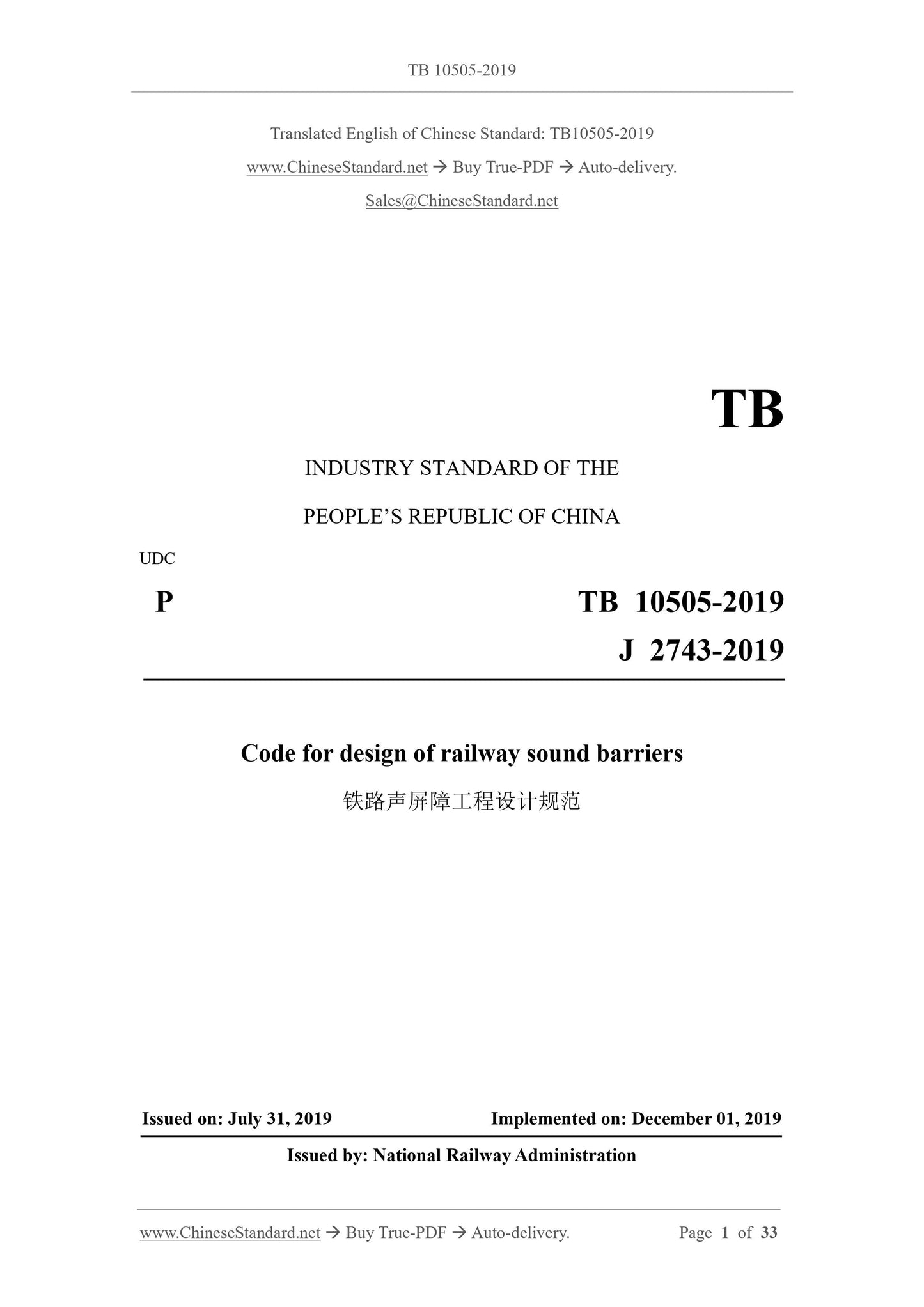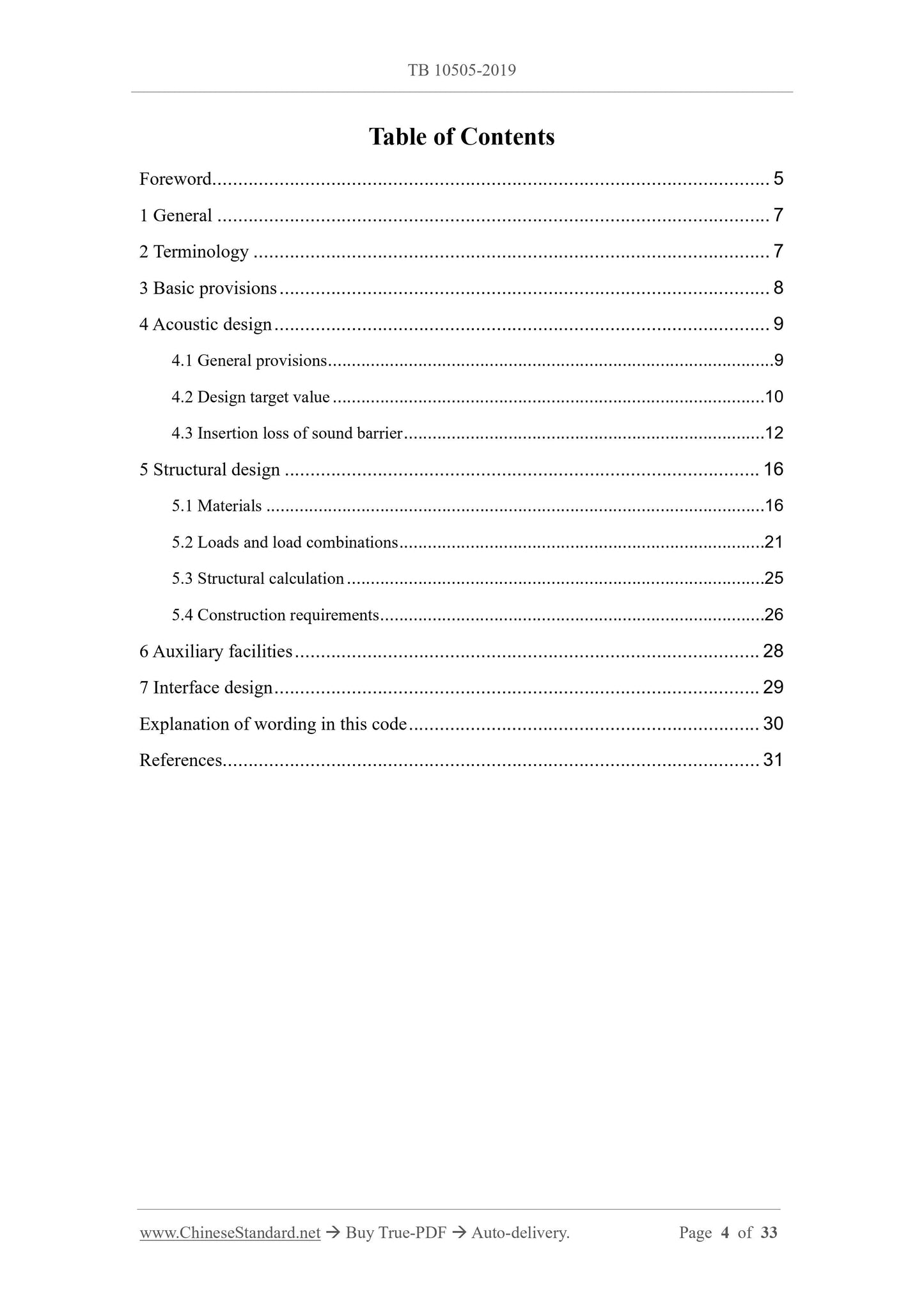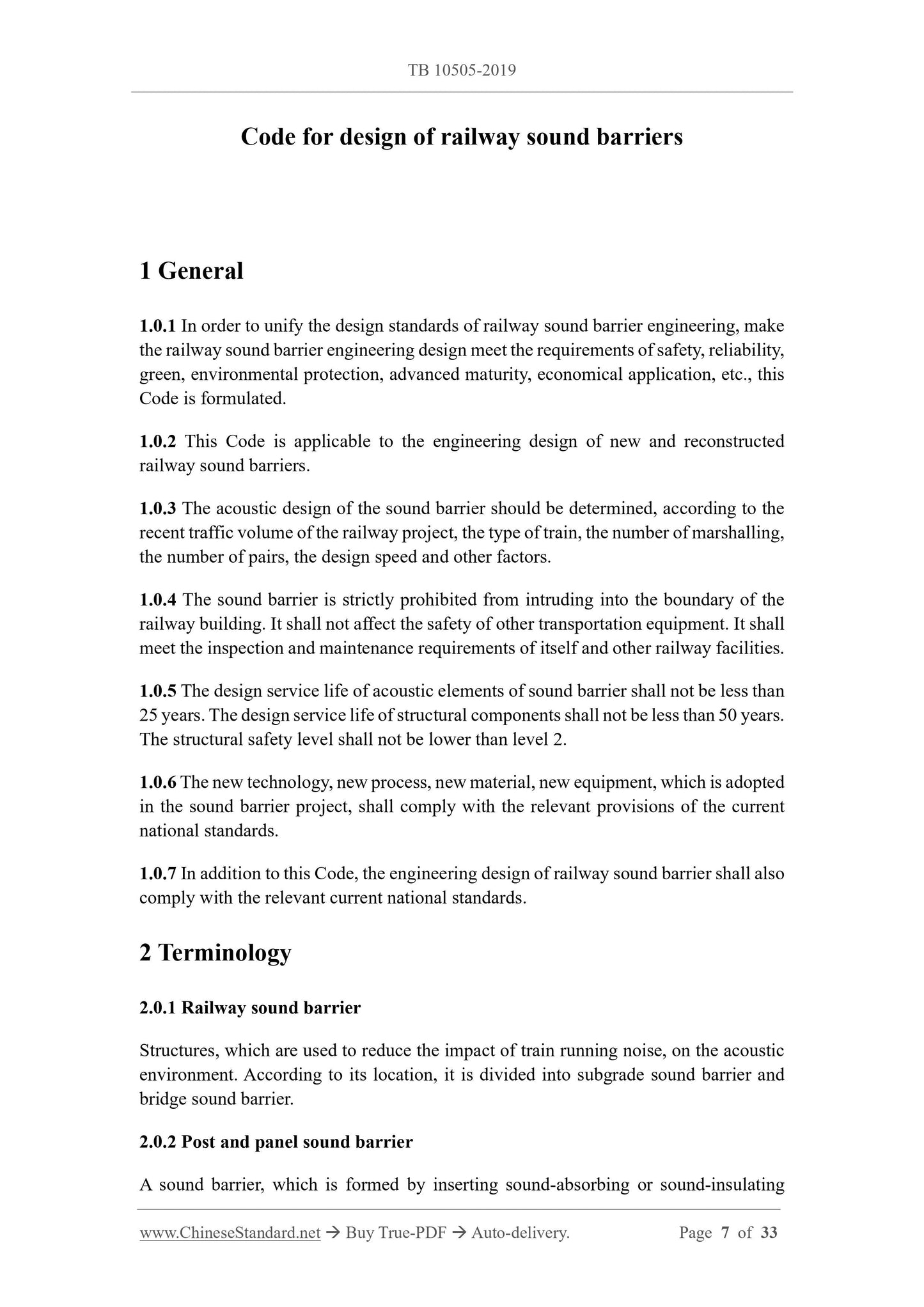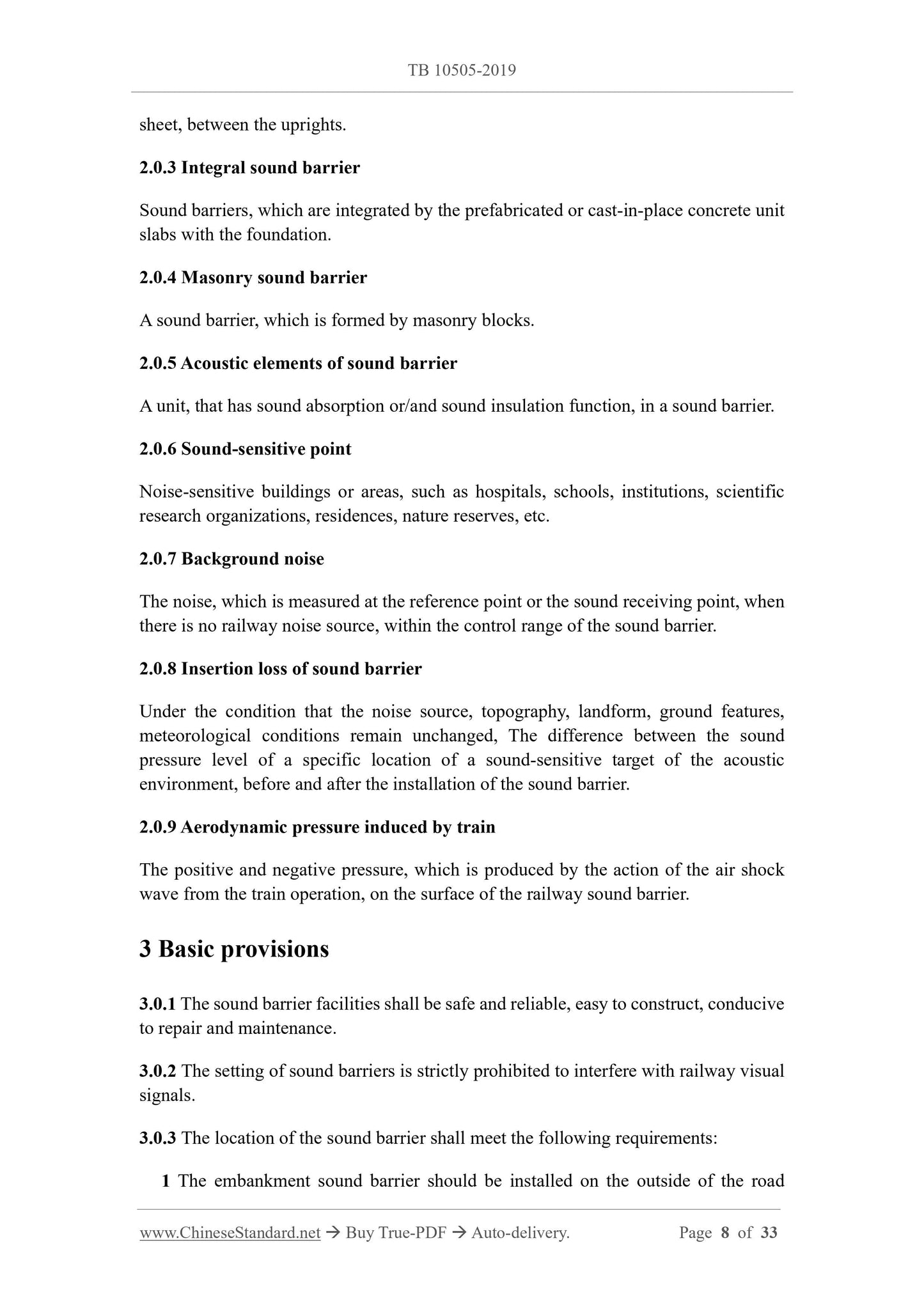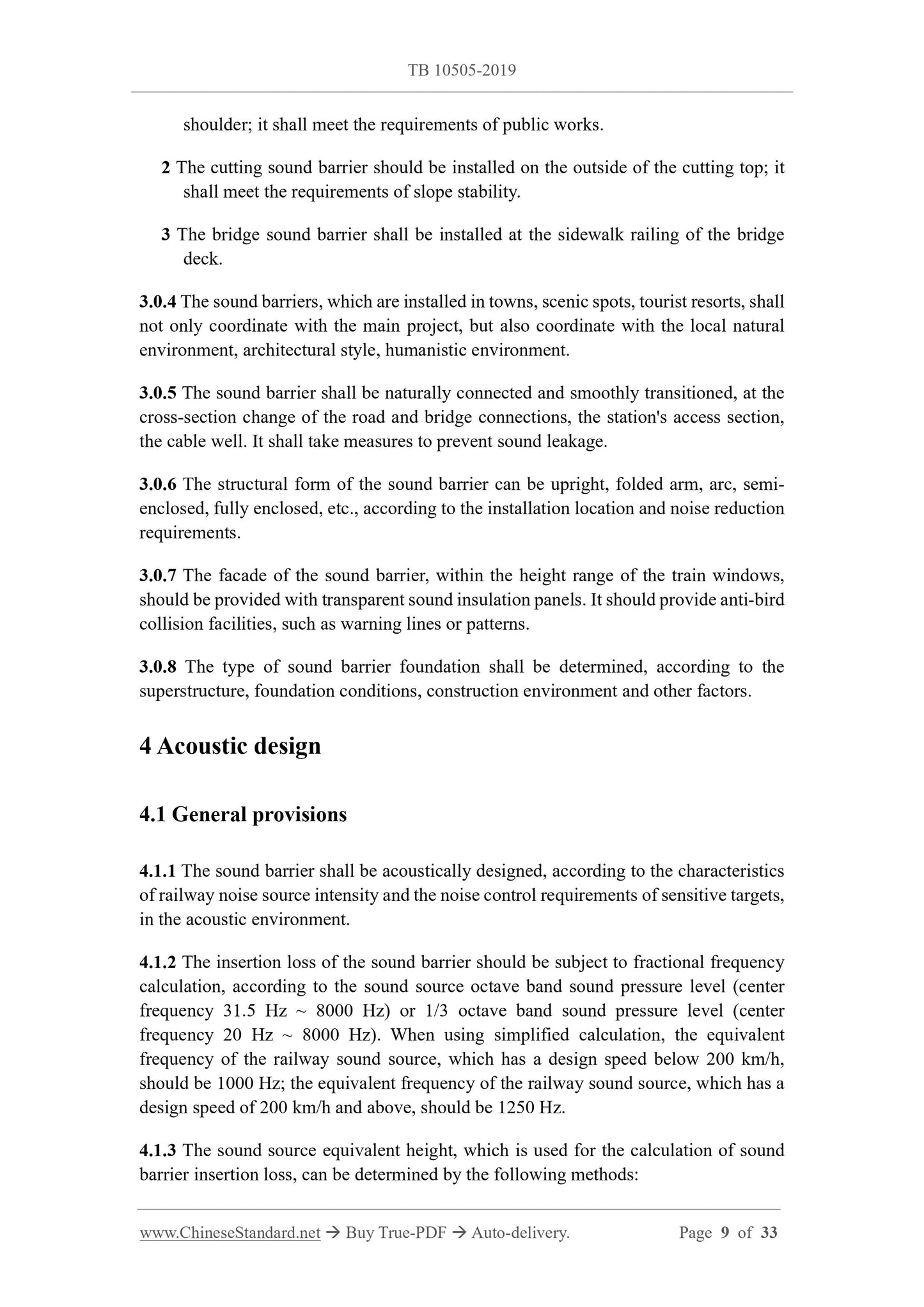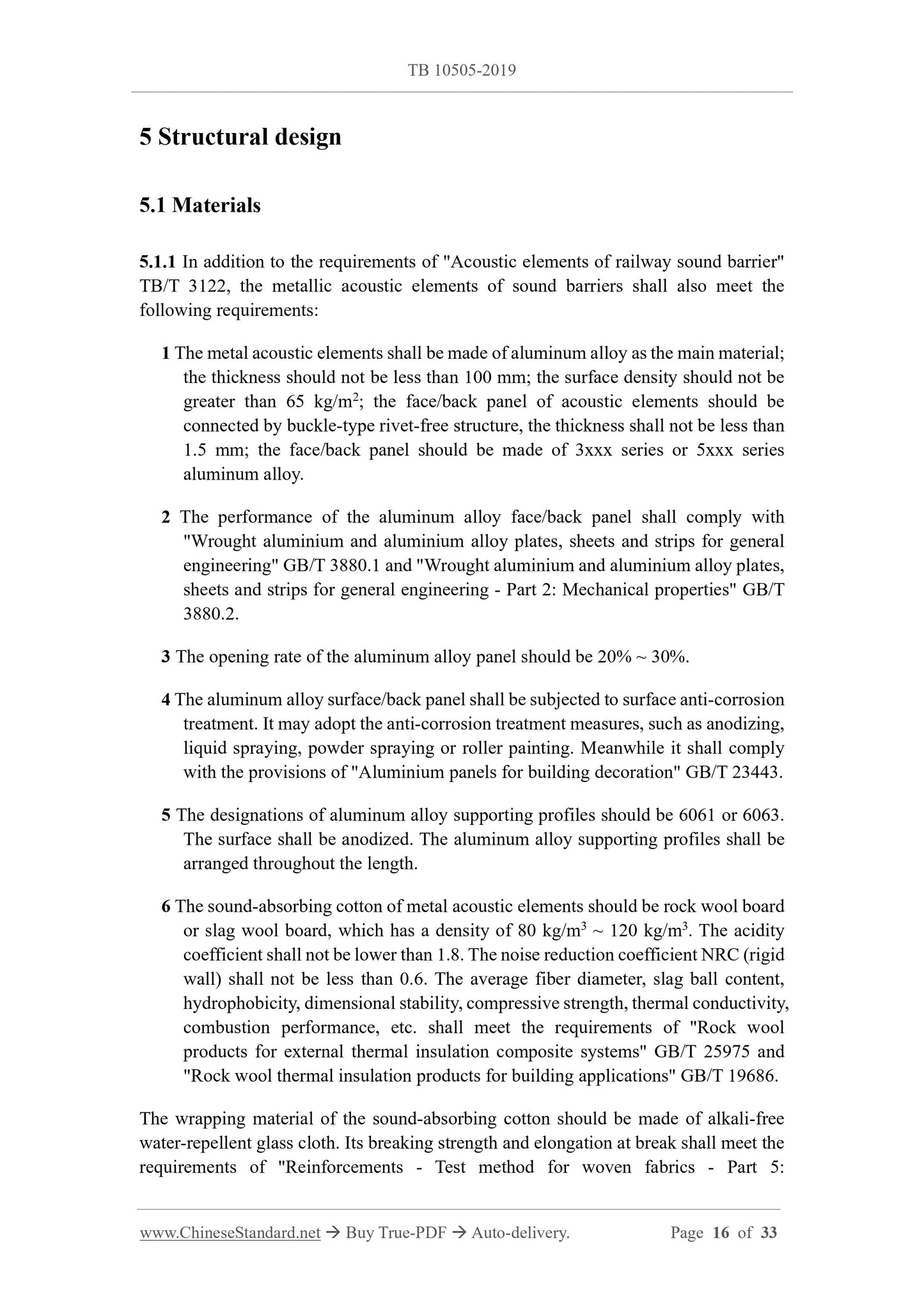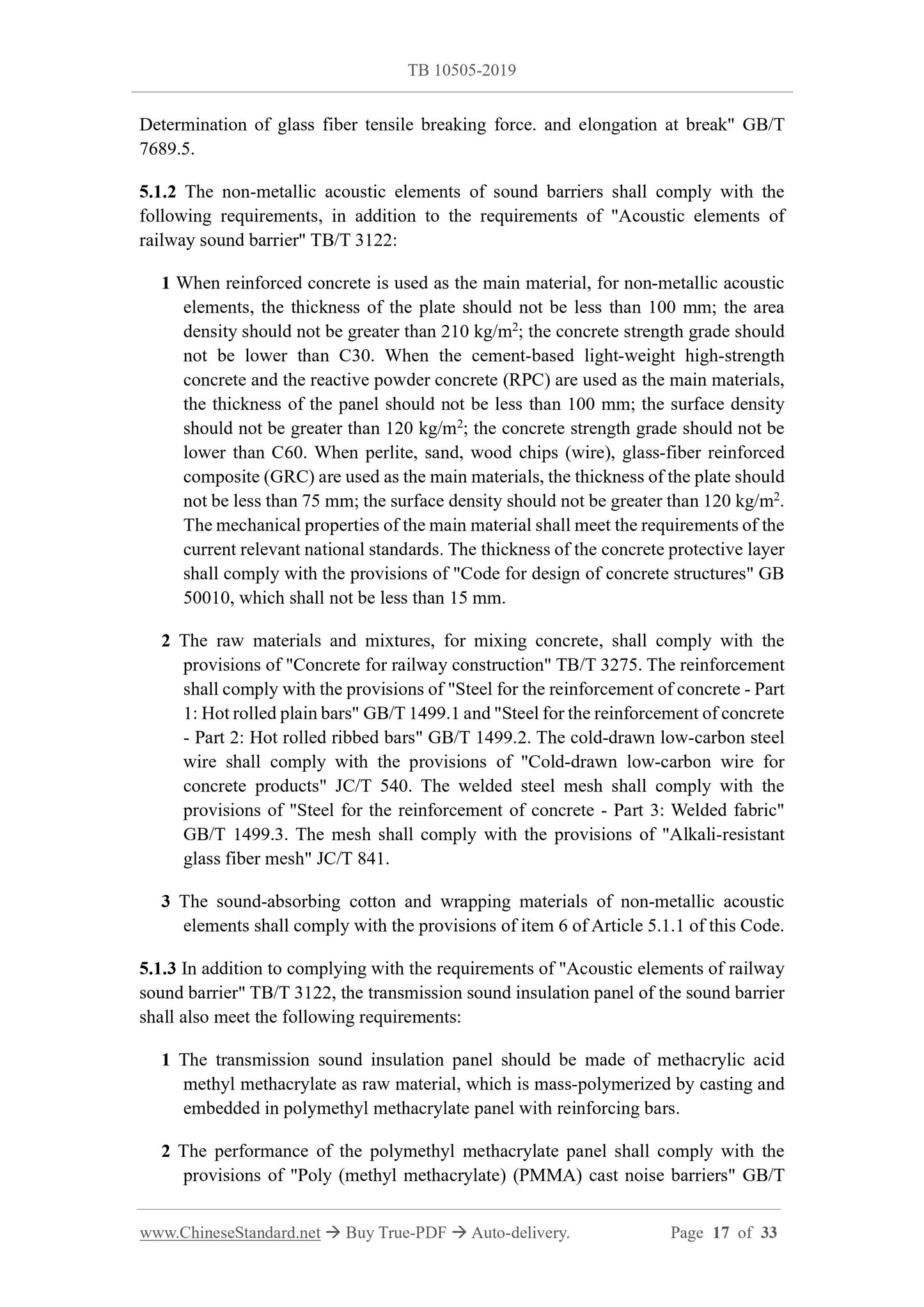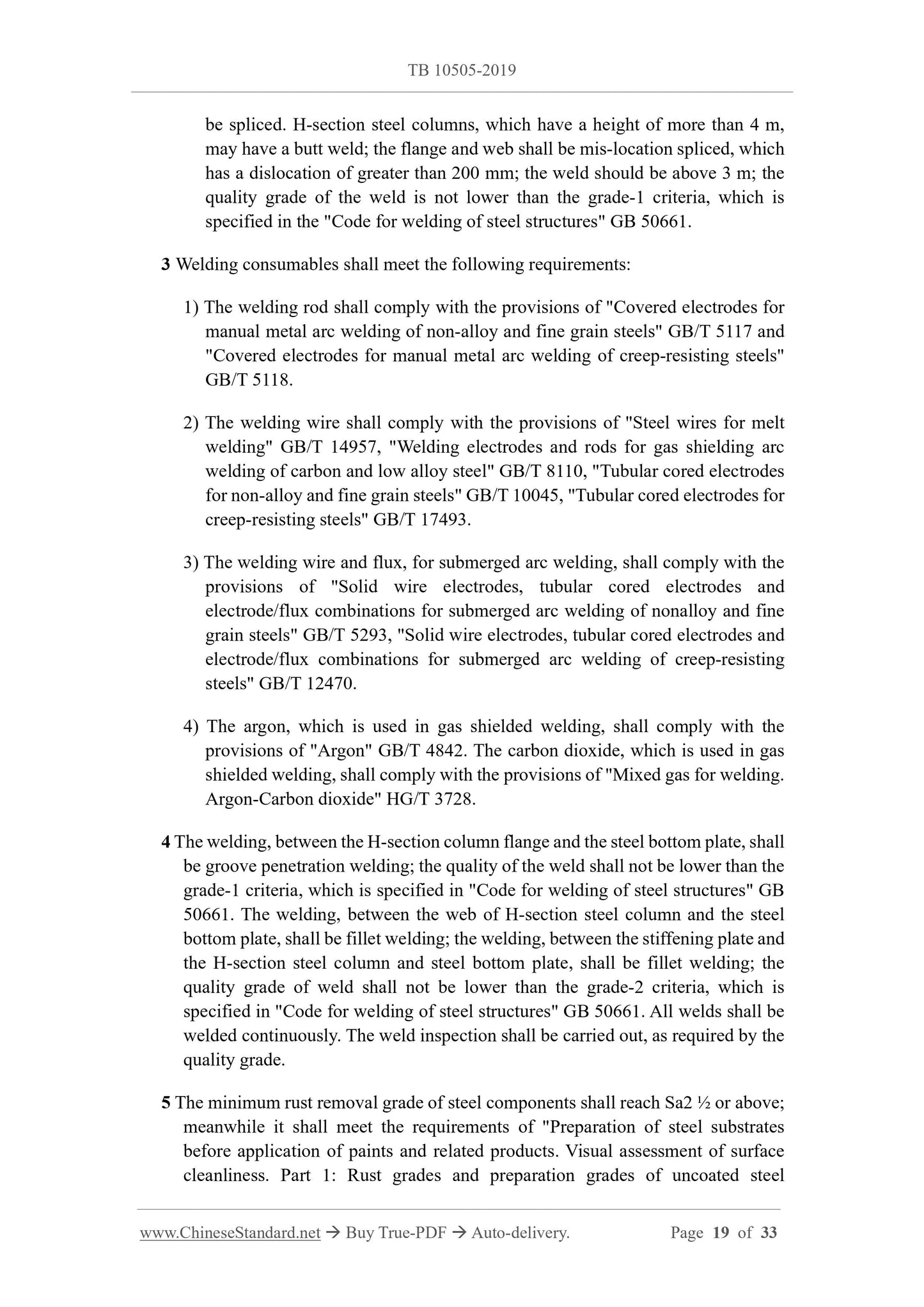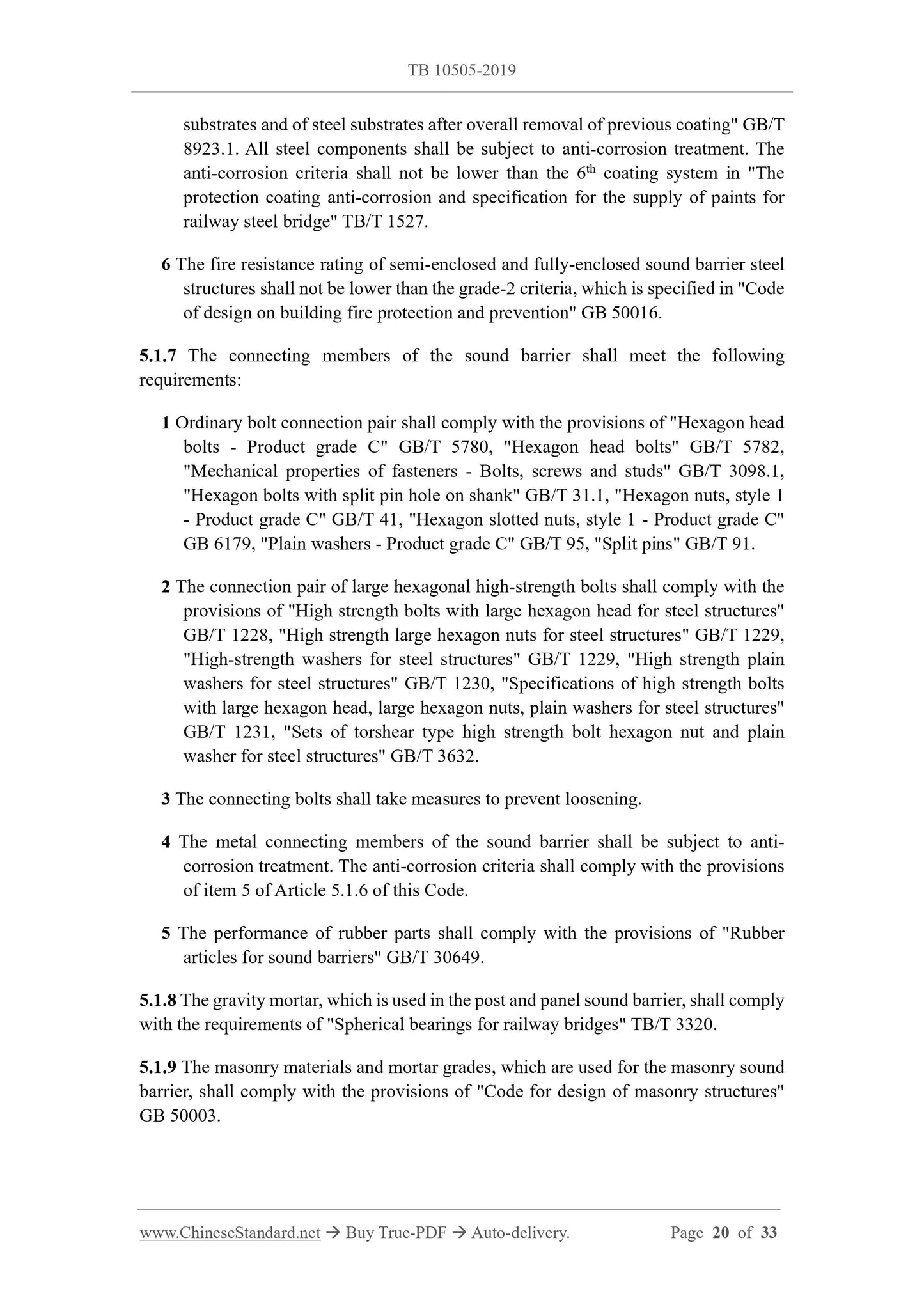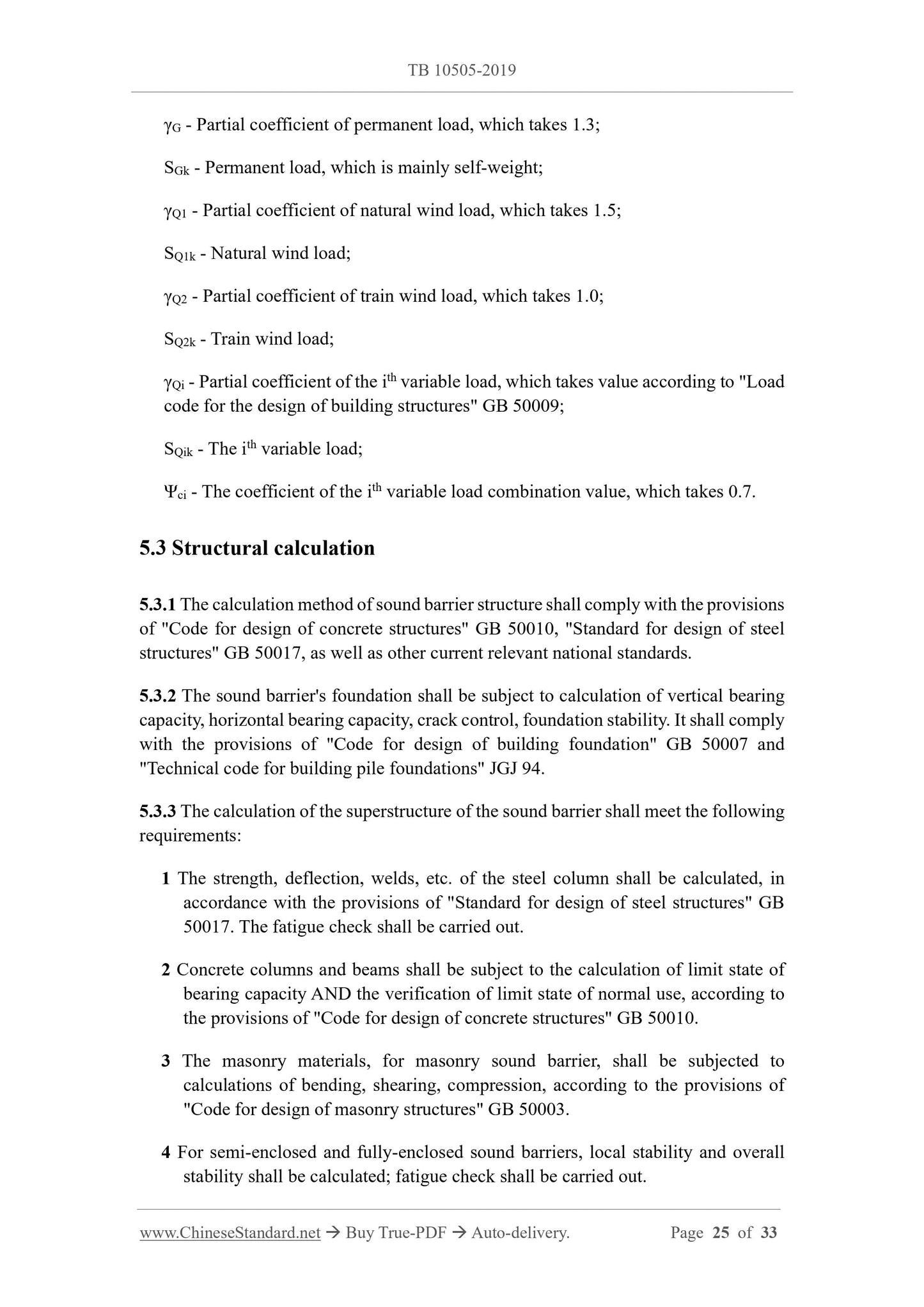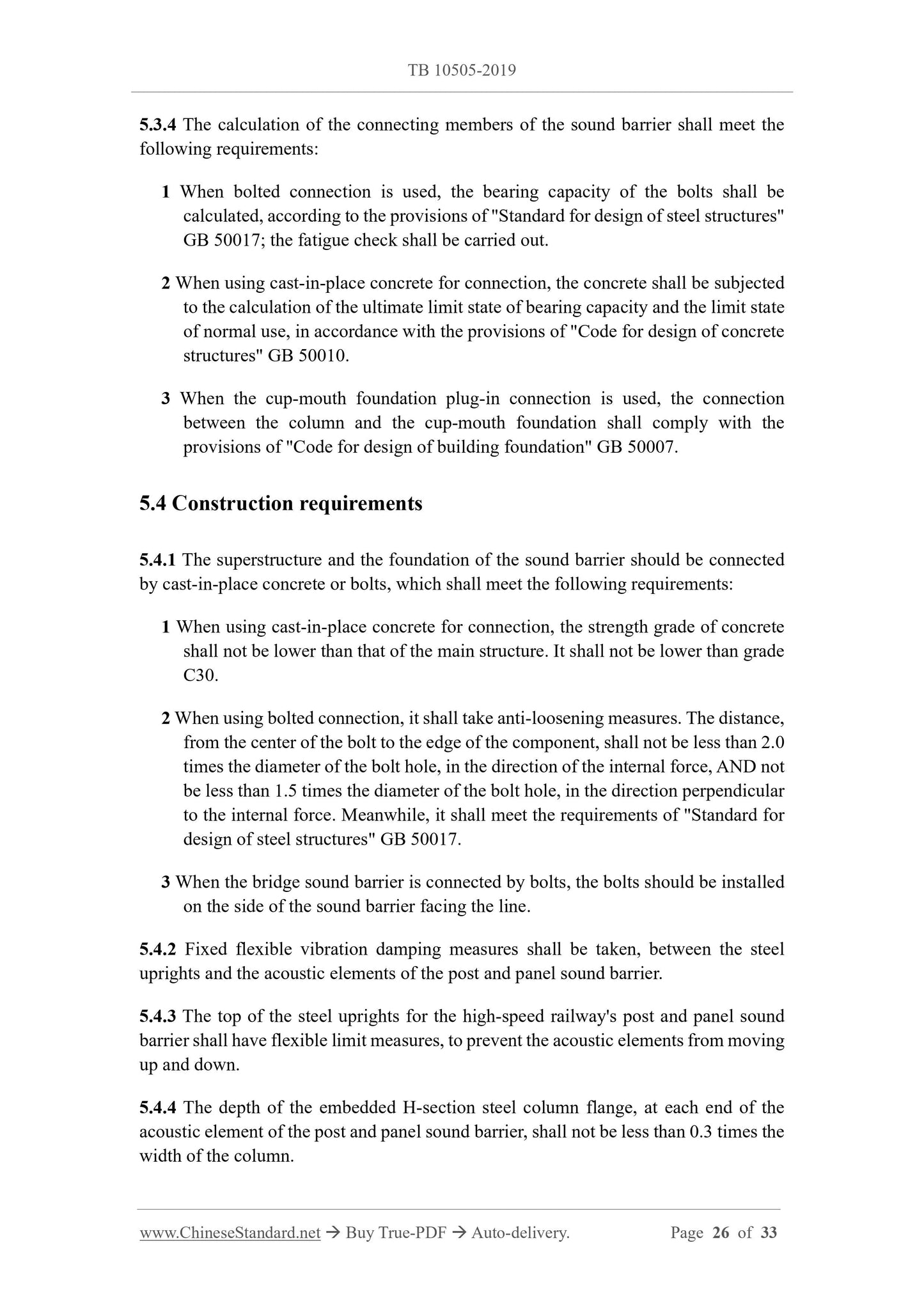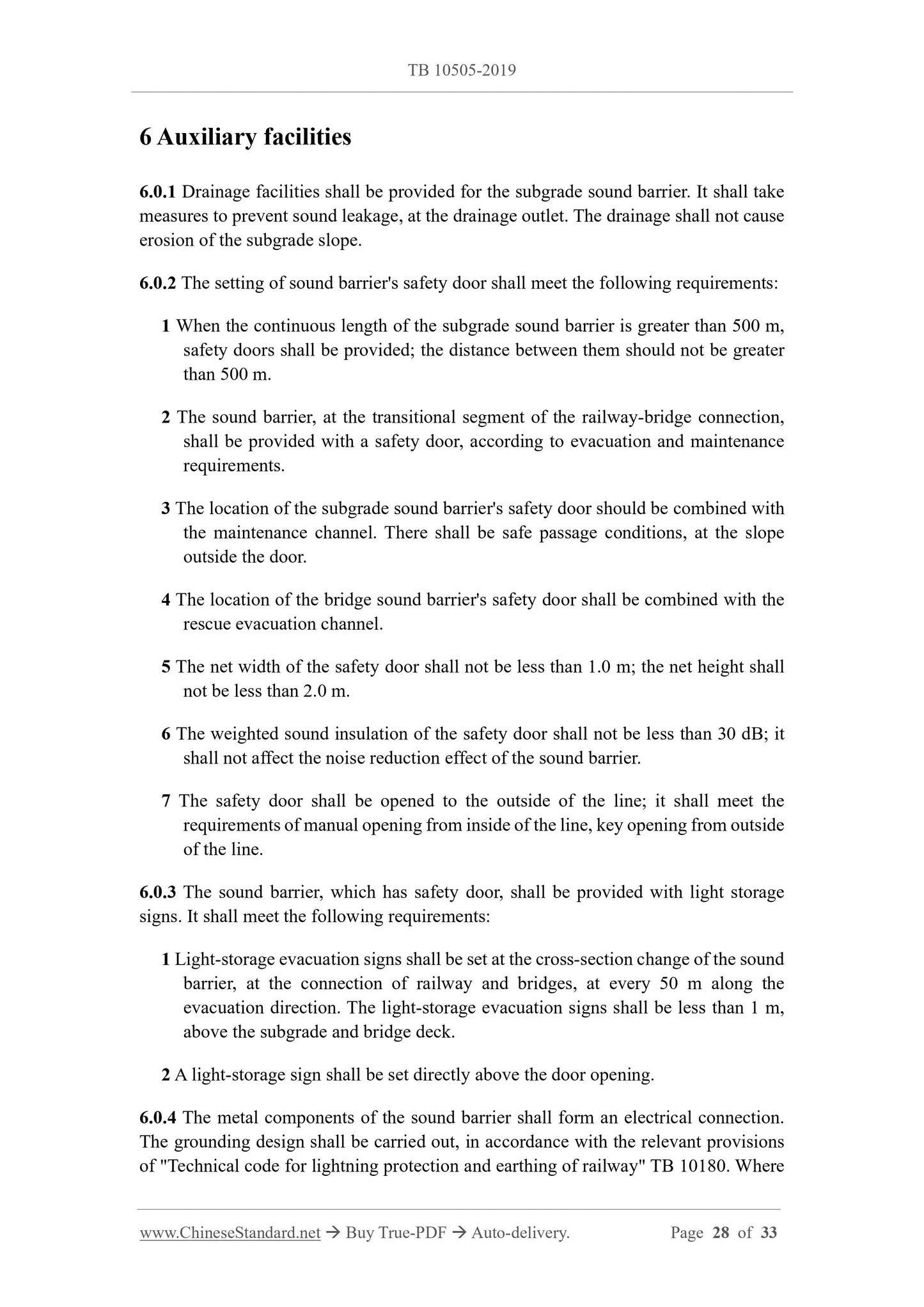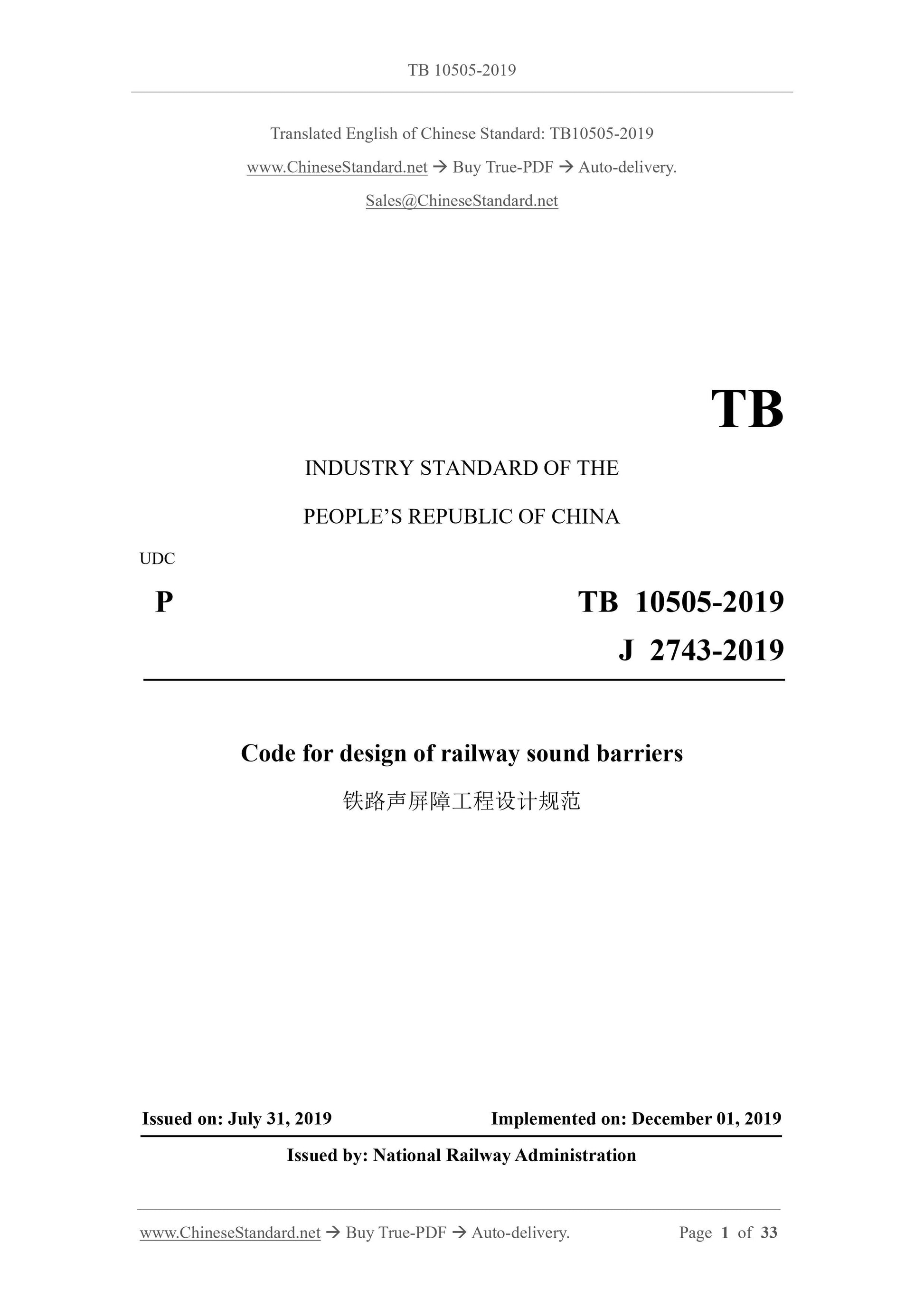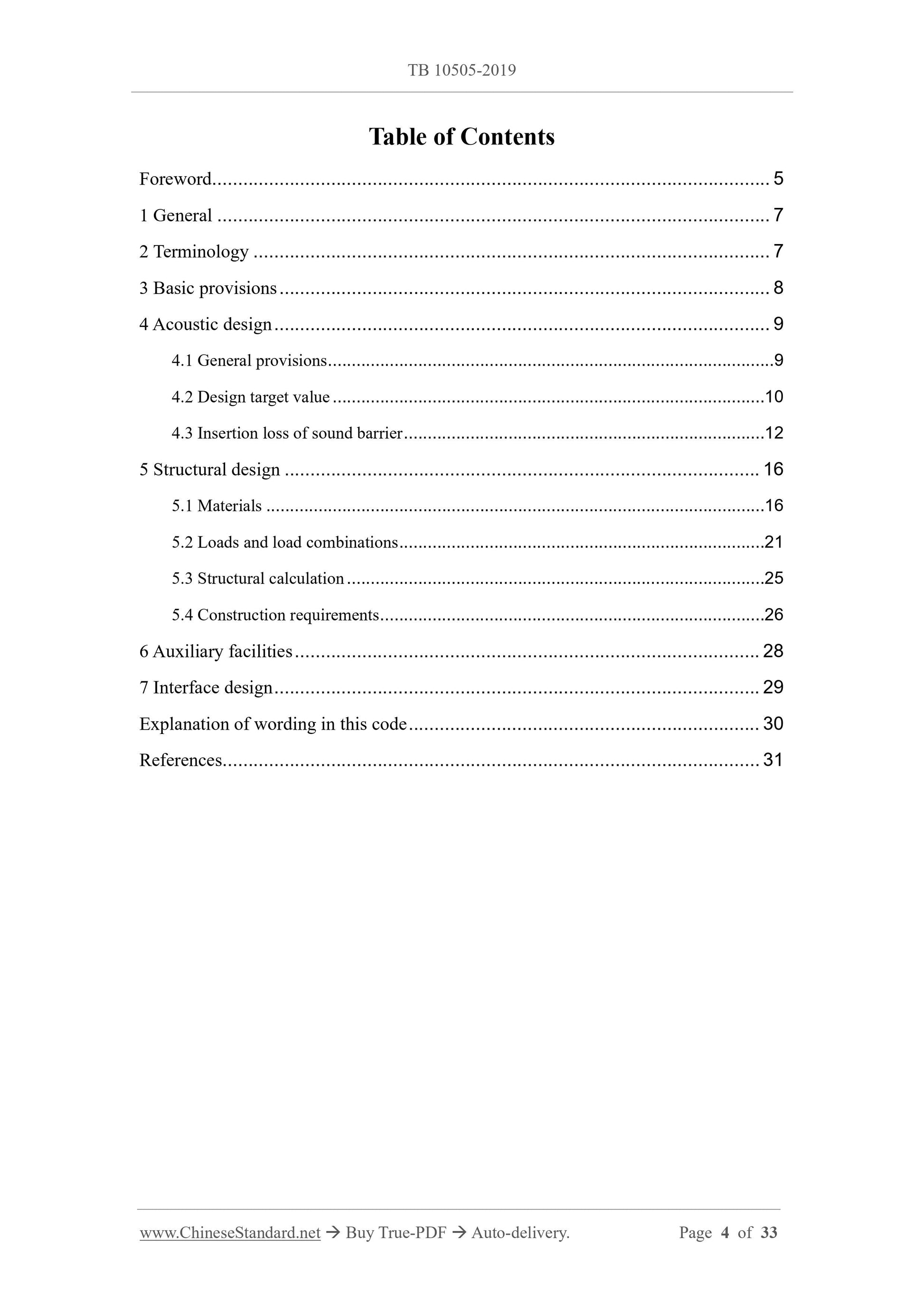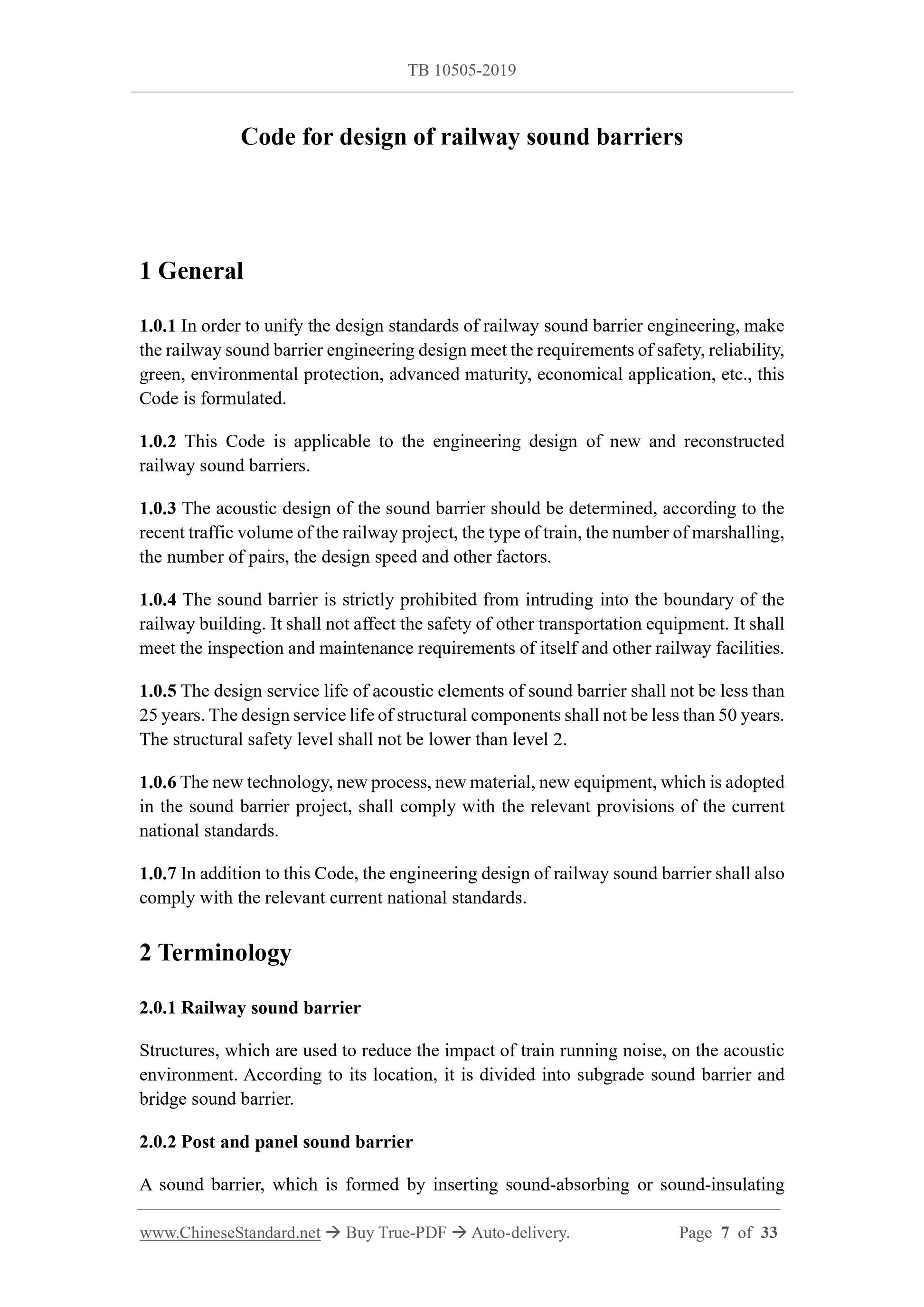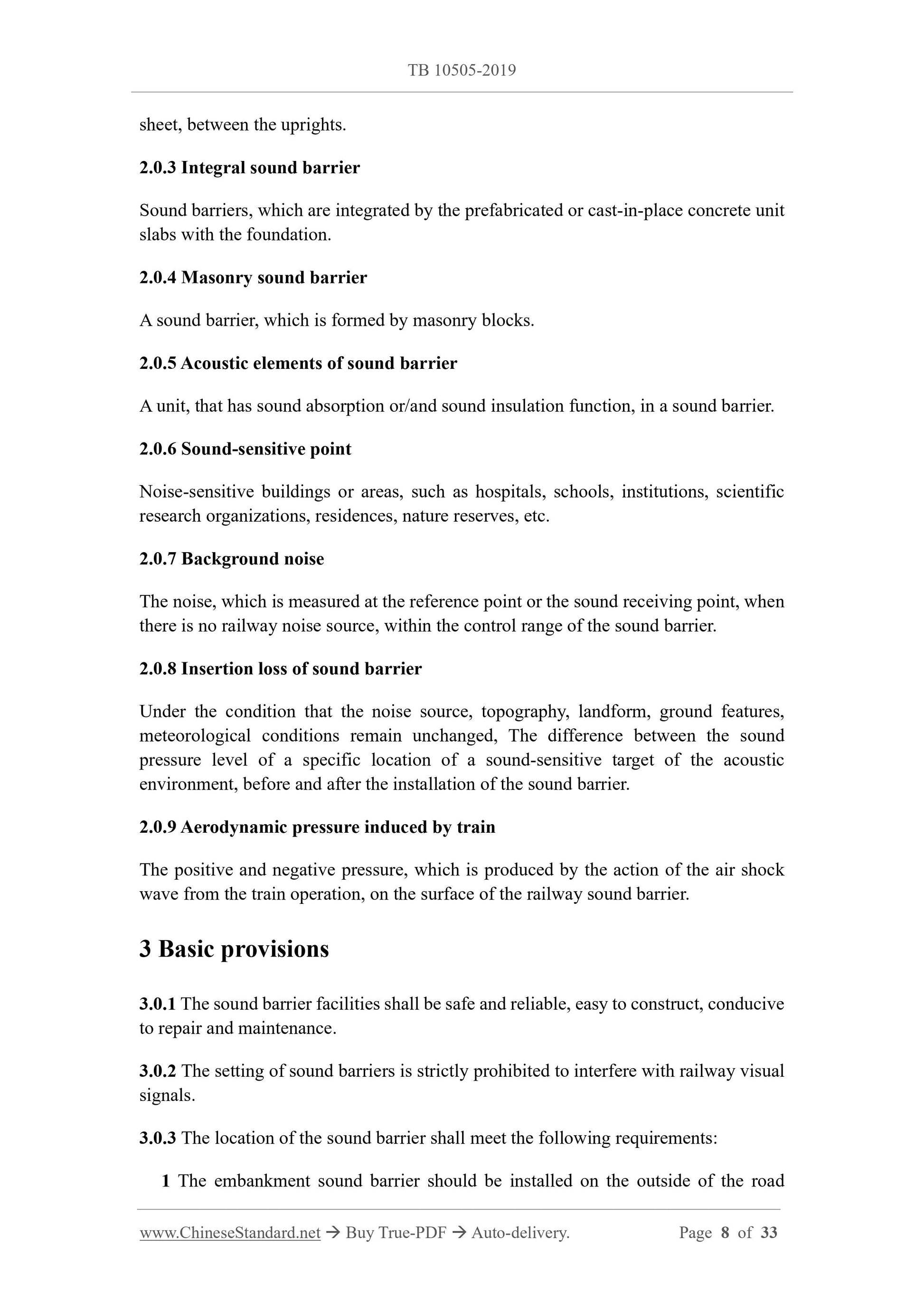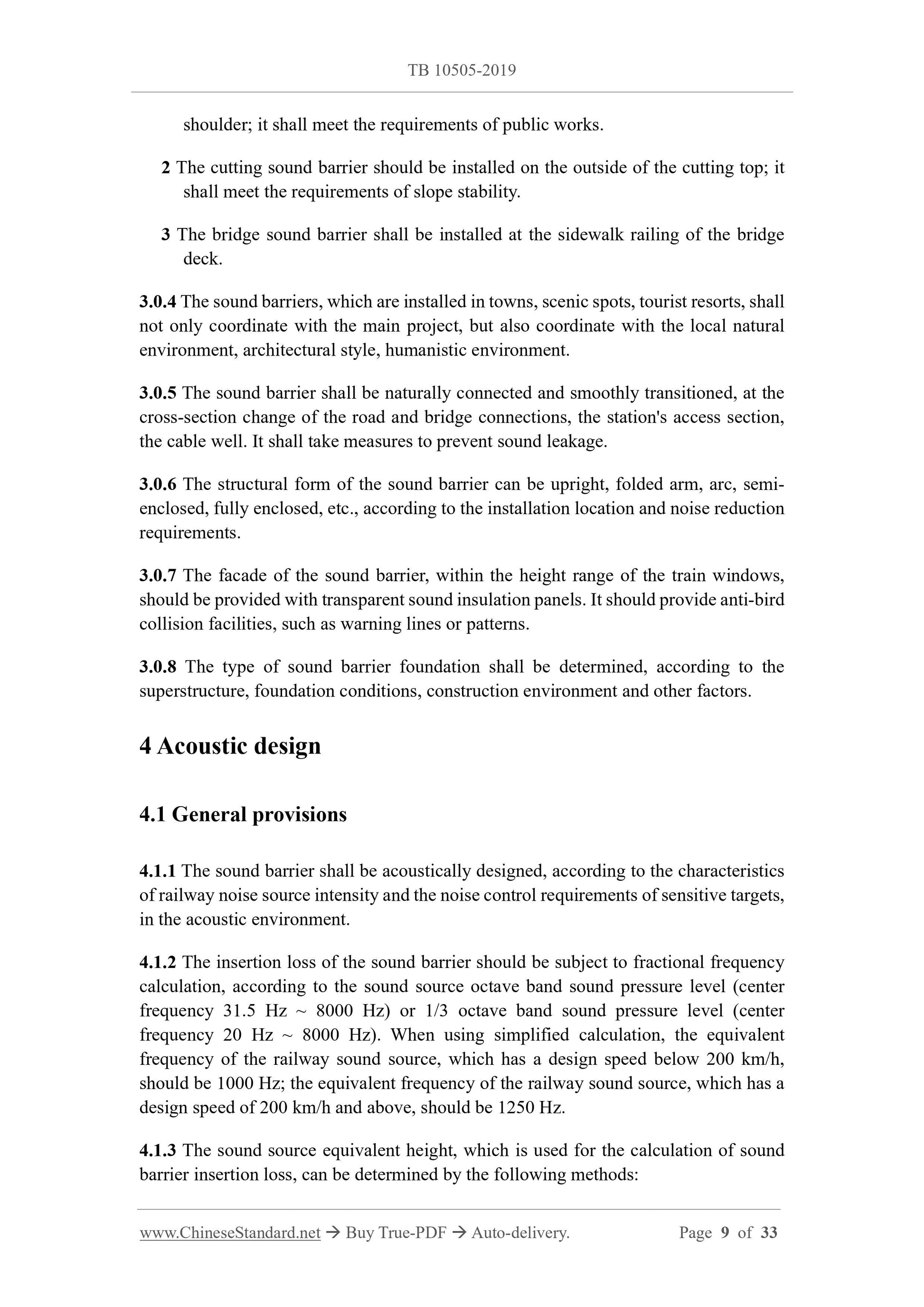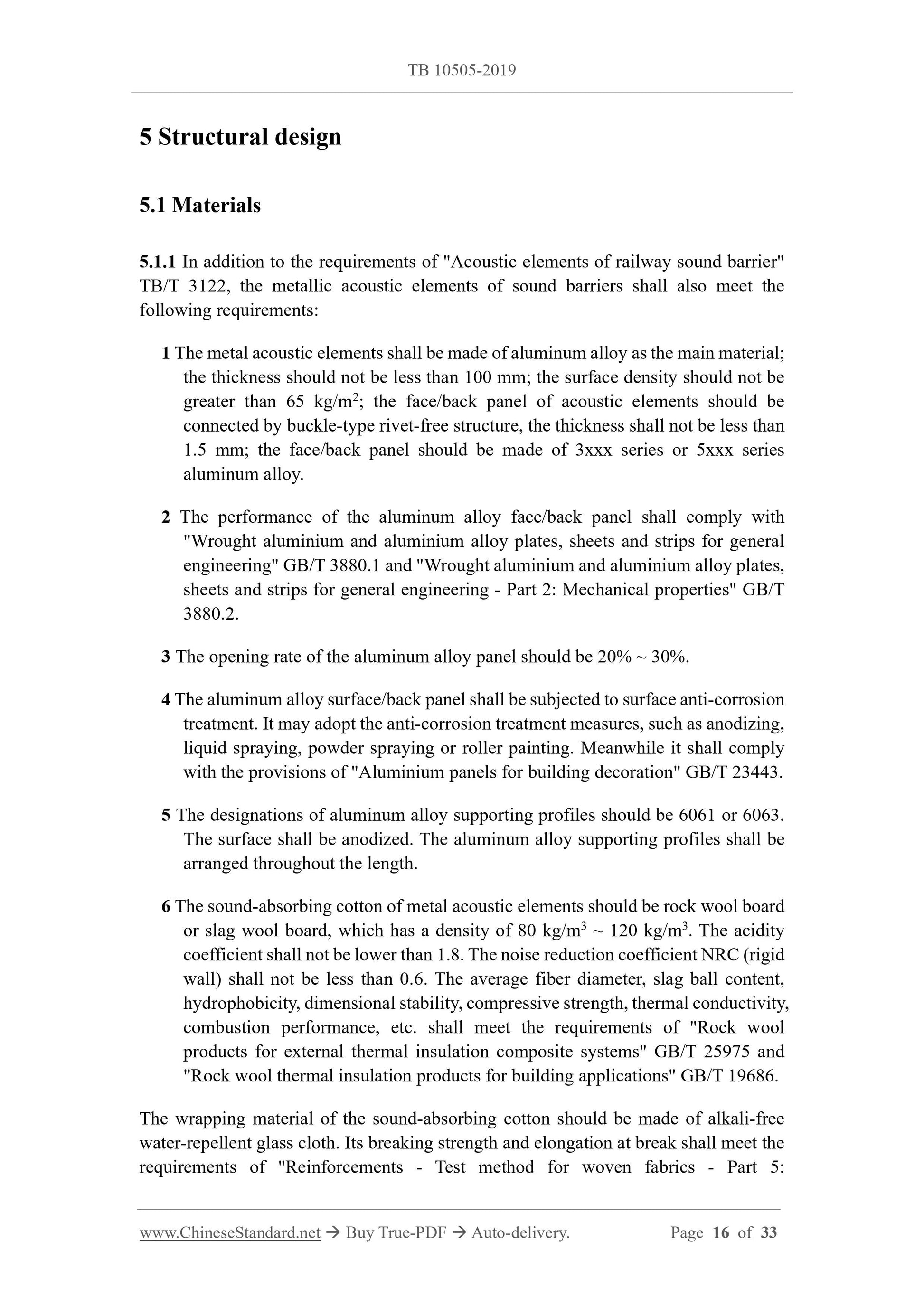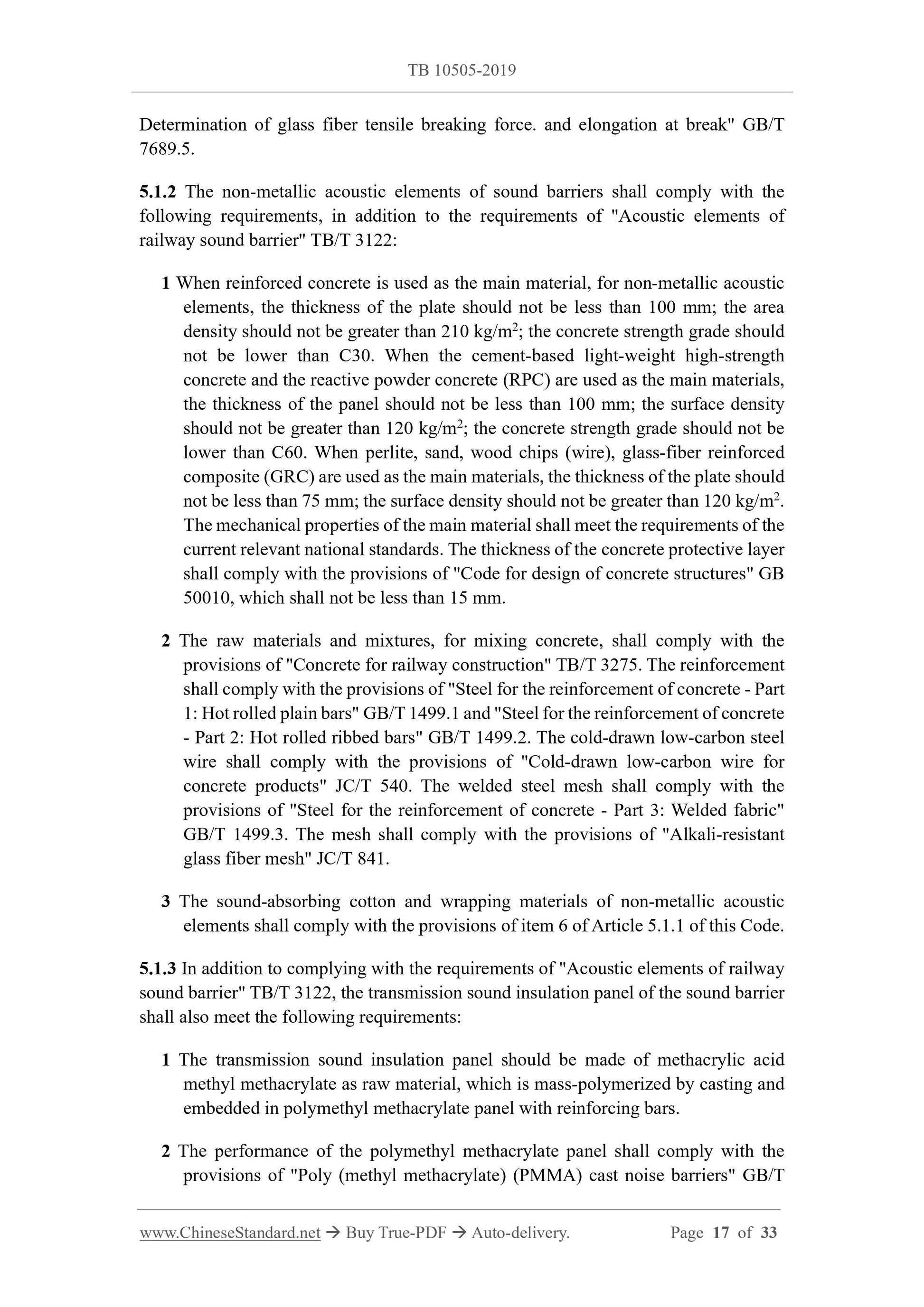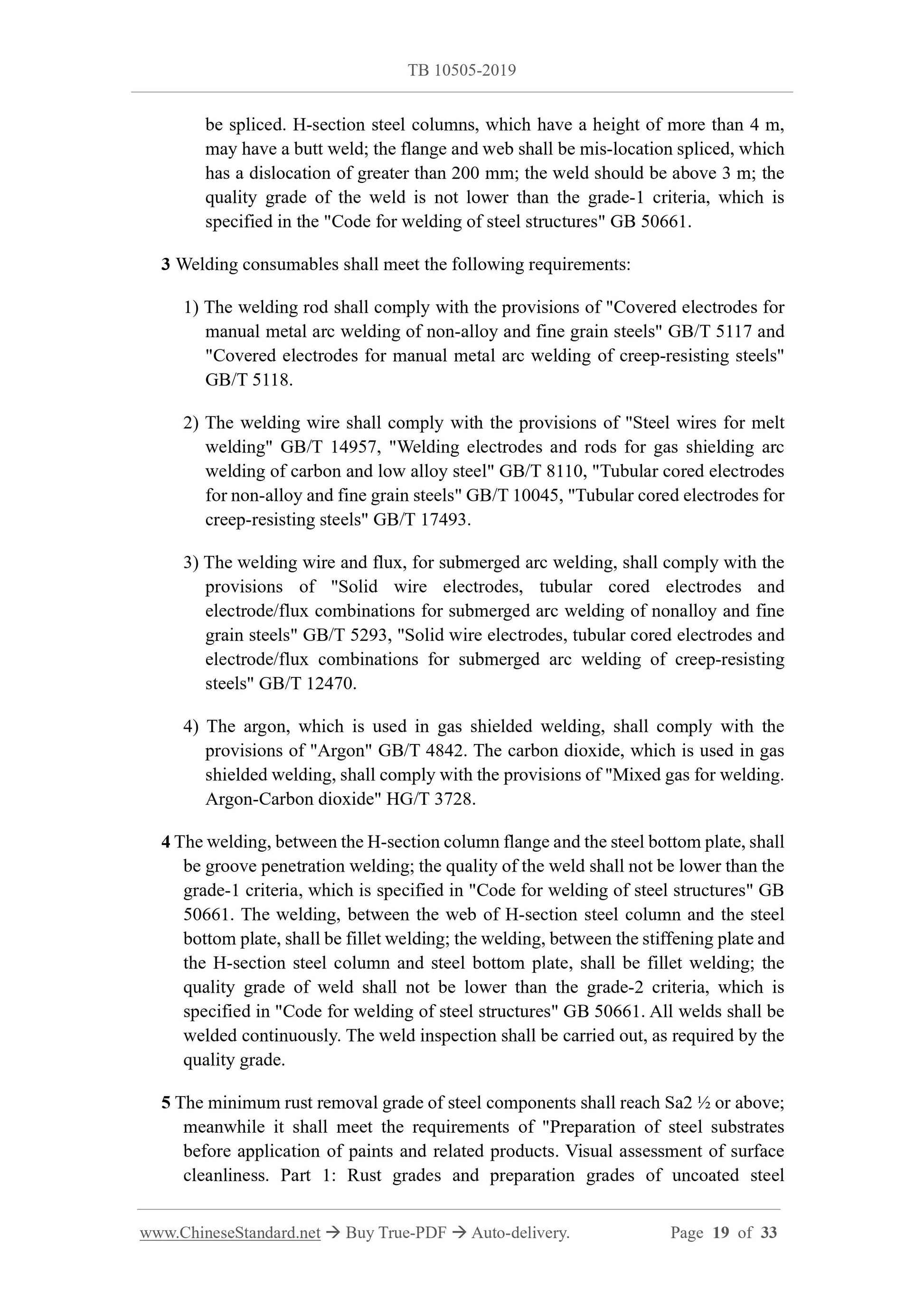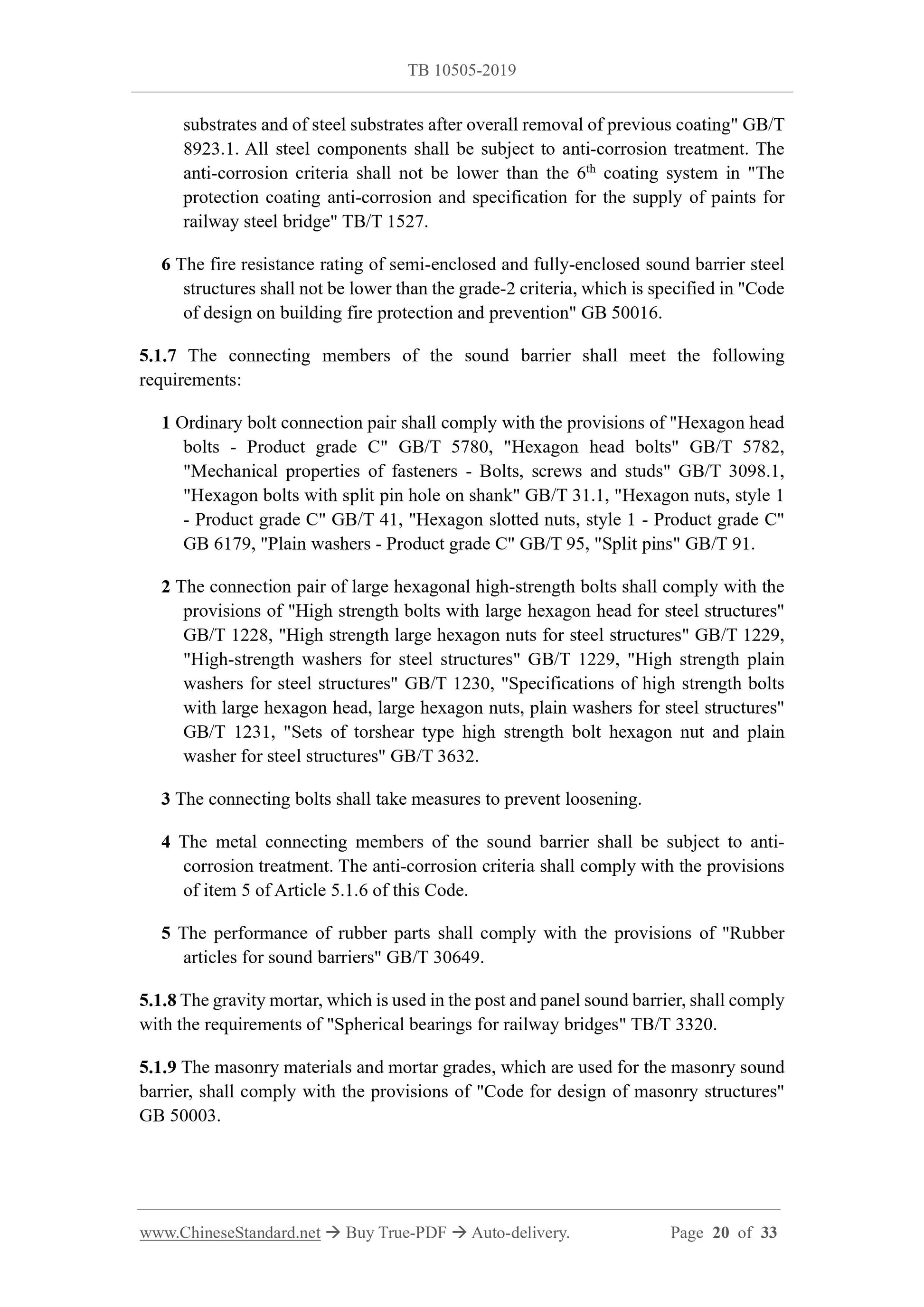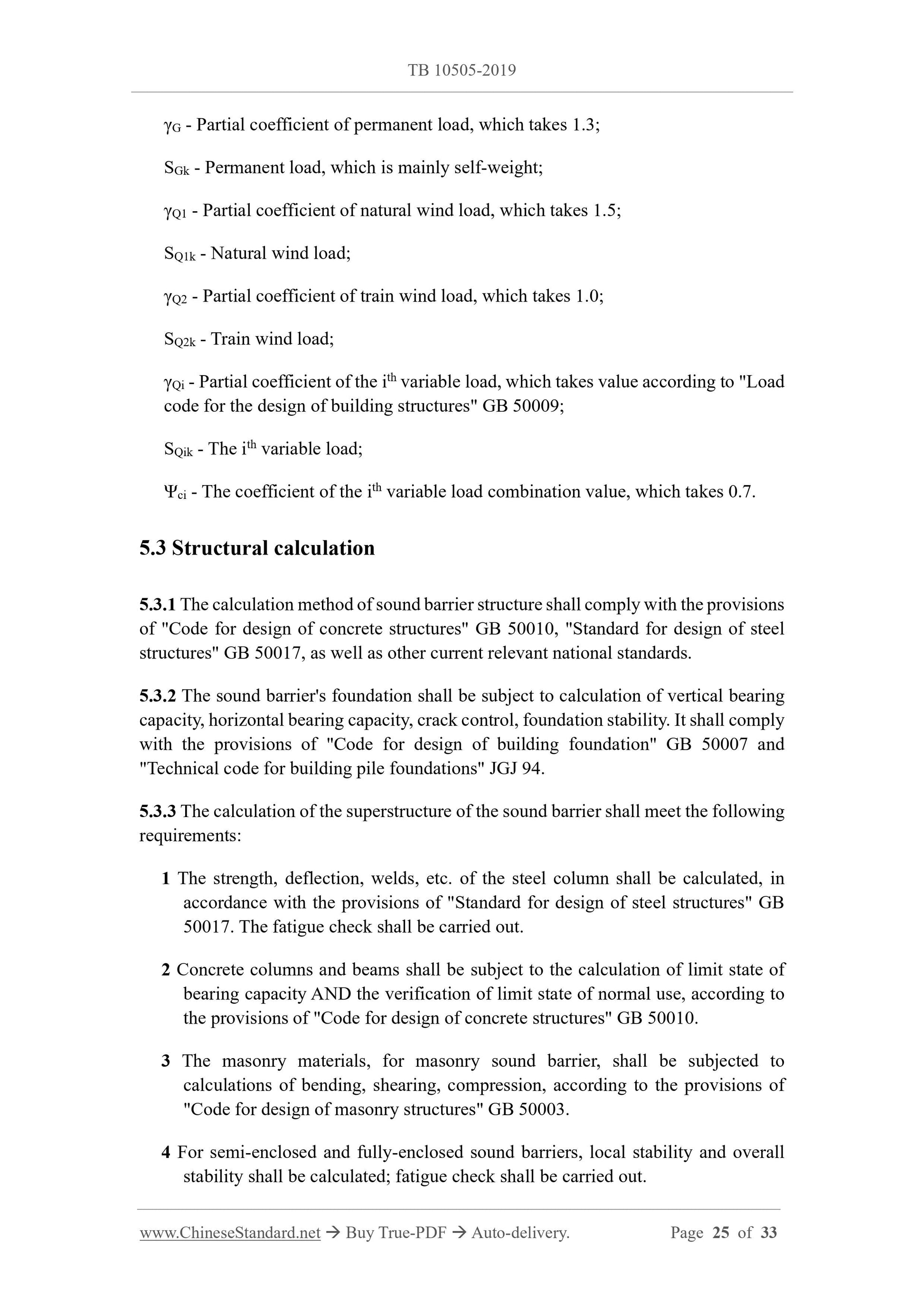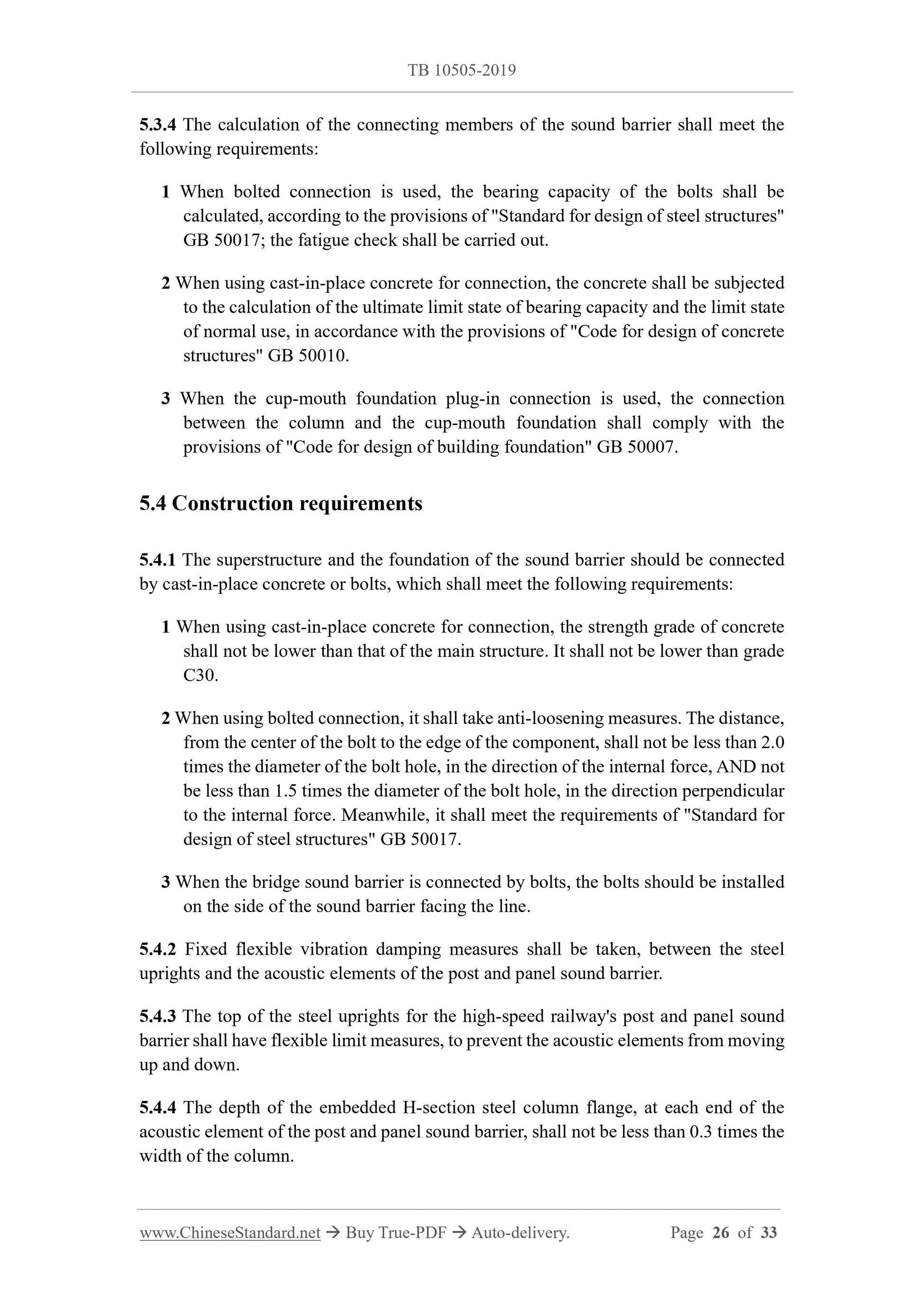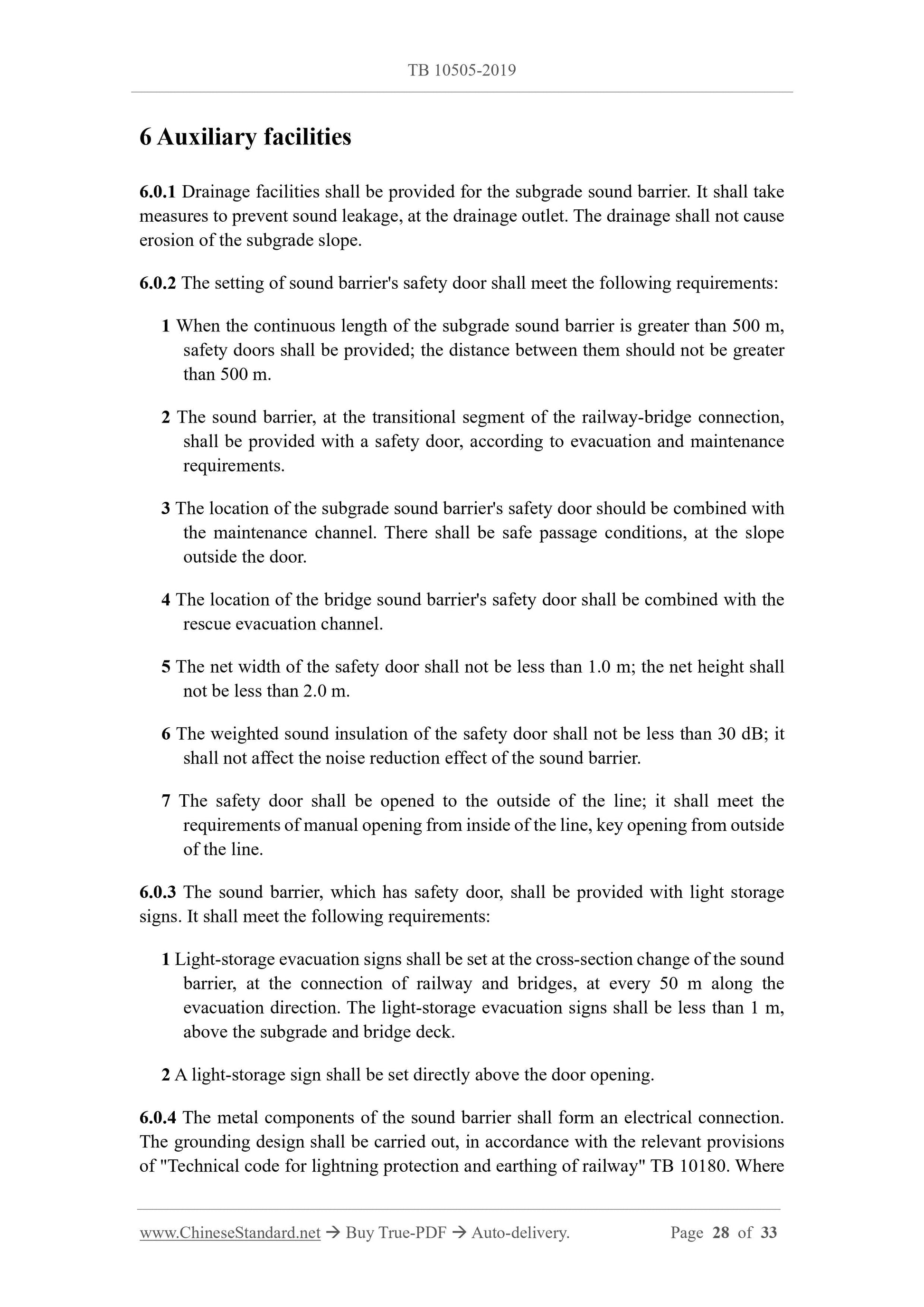PayPal, credit cards. Download editable-PDF and invoice in 1 second!
TB 10505-2019 English PDF (TB10505-2019)
TB 10505-2019 English PDF (TB10505-2019)
Precio habitual
$490.00 USD
Precio habitual
Precio de oferta
$490.00 USD
Precio unitario
/
por
Los gastos de envío se calculan en la pantalla de pago.
No se pudo cargar la disponibilidad de retiro
Delivery: 3 seconds. Download true-PDF + Invoice.
Get QUOTATION in 1-minute: Click TB 10505-2019
Historical versions: TB 10505-2019
Preview True-PDF (Reload/Scroll if blank)
TB 10505-2019: Code for Design of Railway SoundBarriers
TB 10505-2019
INDUSTRY STANDARD OF THE
PEOPLE’S REPUBLIC OF CHINA
UDC
P TB 10505-2019
J 2743-2019
Code for design of railway sound barriers
ISSUED ON: JULY 31, 2019
IMPLEMENTED ON: DECEMBER 01, 2019
Issued by: National Railway Administration
Table of Contents
Foreword ... 5
1 General ... 7
2 Terminology ... 7
3 Basic provisions ... 8
4 Acoustic design ... 9
4.1 General provisions ... 9
4.2 Design target value ... 10
4.3 Insertion loss of sound barrier ... 12
5 Structural design ... 16
5.1 Materials ... 16
5.2 Loads and load combinations ... 21
5.3 Structural calculation ... 25
5.4 Construction requirements ... 26
6 Auxiliary facilities ... 28
7 Interface design ... 29
Explanation of wording in this code ... 30
References ... 31
Code for design of railway sound barriers
1 General
1.0.1 In order to unify the design standards of railway sound barrier engineering, make
the railway sound barrier engineering design meet the requirements of safety, reliability,
green, environmental protection, advanced maturity, economical application, etc., this
Code is formulated.
1.0.2 This Code is applicable to the engineering design of new and reconstructed
railway sound barriers.
1.0.3 The acoustic design of the sound barrier should be determined, according to the
recent traffic volume of the railway project, the type of train, the number of marshalling,
the number of pairs, the design speed and other factors.
1.0.4 The sound barrier is strictly prohibited from intruding into the boundary of the
railway building. It shall not affect the safety of other transportation equipment. It shall
meet the inspection and maintenance requirements of itself and other railway facilities.
1.0.5 The design service life of acoustic elements of sound barrier shall not be less than
25 years. The design service life of structural components shall not be less than 50 years.
The structural safety level shall not be lower than level 2.
1.0.6 The new technology, new process, new material, new equipment, which is adopted
in the sound barrier project, shall comply with the relevant provisions of the current
national standards.
1.0.7 In addition to this Code, the engineering design of railway sound barrier shall also
comply with the relevant current national standards.
2 Terminology
2.0.1 Railway sound barrier
Structures, which are used to reduce the impact of train running noise, on the acoustic
environment. According to its location, it is divided into subgrade sound barrier and
bridge sound barrier.
2.0.2 Post and panel sound barrier
A sound barrier, which is formed by inserting sound-absorbing or sound-insulating
sheet, between the uprights.
2.0.3 Integral sound barrier
Sound barriers, which are integrated by the prefabricated or cast-in-place concrete unit
slabs with the foundation.
2.0.4 Masonry sound barrier
A sound barrier, which is formed by masonry blocks.
2.0.5 Acoustic elements of sound barrier
A unit, that has sound absorption or/and sound insulation function, in a sound barrier.
2.0.6 Sound-sensitive point
Noise-sensitive buildings or areas, such as hospitals, schools, institutions, scientific
research organizations, residences, nature reserves, etc.
2.0.7 Background noise
The noise, which is measured at the reference point or the sound receiving point, when
there is no railway noise source, within the control range of the sound barrier.
2.0.8 Insertion loss of sound barrier
Under the condition that the noise source, topography, landform, ground features,
meteorological conditions remain unchanged, The difference between the sound
pressure level of a specific location of a sound-sensitive target of the acoustic
environment, before and after the installation of the sound barrier.
2.0.9 Aerodynamic pressure induced by train
The positive and negative pressure, which is produced by the action of the air shock
wave from the train operation, on the surface of the railway sound barrier.
3 Basic provisions
3.0.1 The sound barrier facilities shall be safe and reliable, easy to construct, conducive
to repair and maintenance.
3.0.2 The setting of sound barriers is strictly prohibited to interfere with railway visual
signals.
3.0.3 The location of the sound barrier shall meet the following requirements:
1 The embankment sound barrier should be installed on the outside of the road
shoulder; it shall meet the requirements of public works.
2 The cutting sound barrier should be installed on the outside of the cutting top; it
shall meet the requirements of slope stability.
3 The bridge sound barrier shall be installed at the sidewalk railing of the bridge
deck.
3.0.4 The sound barriers, which are installed in towns, scenic spots, tourist resorts, shall
not only coordinate with the main project, but also coordinate with the local natural
environment, architectural style, humanistic environment.
3.0.5 The sound barrier shall be naturally connected and smoothly transitioned, at the
cross-section change of the road and bridge connections, the station's access section,
the cable well. It shall take measures to prevent sound leakage.
3.0.6 The structural form of the sound barrier can be upright, folded arm, arc, semi-
enclosed, fully enclosed, etc., according to the installation location and noise reduction
requirements.
3.0.7 The facade of the sound barrier, within the height range of the train windows,
should be provided with transparent sound insulation panels. It should provide anti-bird
collision facilities, such as warning lines or patterns.
3.0.8 The type of sound barrier foundation shall be determined, according to the
superstructure, foundation conditions, construction environment and other factors.
4 Acoustic design
4.1 General provisions
4.1.1 The sound barrier shall be acoustically designed, according to the characteristics
of railway noise source intensity and the noise control requirements of sensitive targets,
in the acoustic environment.
4.1.2 The insertion loss of the sound barrier should be subject to fractional frequency
calculation, according to the sound source octave band sound pressure level (center
frequency 31.5 Hz ~ 8000 Hz) or 1/3 octave band sound pressure level (center
frequency 20 Hz ~ 8000 Hz). When using simplified calculation, the equivalent
frequency of the railway sound source, which has a design speed below 200 km/h,
should be 1000 Hz; the equivalent frequency of the railway sound source, which has a
design speed of 200 km/h and above, should be 1250 Hz.
4.1.3 The sound source equivalent height, which is used for the calculation of sound
barrier insertion loss, can be determined by the following methods:
5 Structural design
5.1 Materials
5.1.1 In addition to the requirements of "Acoustic elements of railway sound barrier"
TB/T 3122, the metallic acoustic elements of sound barriers shall also meet the
following requirements:
1 The metal acoustic elements shall be made of aluminum alloy as the main material;
the thickness should not be less than 100 mm; the surface density should not be
greater than 65 kg/m2; the face/back panel of acoustic elements should be
connected by buckle-type rivet-free structure, the thickness shall not be less than
1.5 mm; the face/back panel should be made of 3xxx series or 5xxx series
aluminum alloy.
2 The performance of the aluminum alloy face/back panel shall comply with
"Wrough...
Get QUOTATION in 1-minute: Click TB 10505-2019
Historical versions: TB 10505-2019
Preview True-PDF (Reload/Scroll if blank)
TB 10505-2019: Code for Design of Railway SoundBarriers
TB 10505-2019
INDUSTRY STANDARD OF THE
PEOPLE’S REPUBLIC OF CHINA
UDC
P TB 10505-2019
J 2743-2019
Code for design of railway sound barriers
ISSUED ON: JULY 31, 2019
IMPLEMENTED ON: DECEMBER 01, 2019
Issued by: National Railway Administration
Table of Contents
Foreword ... 5
1 General ... 7
2 Terminology ... 7
3 Basic provisions ... 8
4 Acoustic design ... 9
4.1 General provisions ... 9
4.2 Design target value ... 10
4.3 Insertion loss of sound barrier ... 12
5 Structural design ... 16
5.1 Materials ... 16
5.2 Loads and load combinations ... 21
5.3 Structural calculation ... 25
5.4 Construction requirements ... 26
6 Auxiliary facilities ... 28
7 Interface design ... 29
Explanation of wording in this code ... 30
References ... 31
Code for design of railway sound barriers
1 General
1.0.1 In order to unify the design standards of railway sound barrier engineering, make
the railway sound barrier engineering design meet the requirements of safety, reliability,
green, environmental protection, advanced maturity, economical application, etc., this
Code is formulated.
1.0.2 This Code is applicable to the engineering design of new and reconstructed
railway sound barriers.
1.0.3 The acoustic design of the sound barrier should be determined, according to the
recent traffic volume of the railway project, the type of train, the number of marshalling,
the number of pairs, the design speed and other factors.
1.0.4 The sound barrier is strictly prohibited from intruding into the boundary of the
railway building. It shall not affect the safety of other transportation equipment. It shall
meet the inspection and maintenance requirements of itself and other railway facilities.
1.0.5 The design service life of acoustic elements of sound barrier shall not be less than
25 years. The design service life of structural components shall not be less than 50 years.
The structural safety level shall not be lower than level 2.
1.0.6 The new technology, new process, new material, new equipment, which is adopted
in the sound barrier project, shall comply with the relevant provisions of the current
national standards.
1.0.7 In addition to this Code, the engineering design of railway sound barrier shall also
comply with the relevant current national standards.
2 Terminology
2.0.1 Railway sound barrier
Structures, which are used to reduce the impact of train running noise, on the acoustic
environment. According to its location, it is divided into subgrade sound barrier and
bridge sound barrier.
2.0.2 Post and panel sound barrier
A sound barrier, which is formed by inserting sound-absorbing or sound-insulating
sheet, between the uprights.
2.0.3 Integral sound barrier
Sound barriers, which are integrated by the prefabricated or cast-in-place concrete unit
slabs with the foundation.
2.0.4 Masonry sound barrier
A sound barrier, which is formed by masonry blocks.
2.0.5 Acoustic elements of sound barrier
A unit, that has sound absorption or/and sound insulation function, in a sound barrier.
2.0.6 Sound-sensitive point
Noise-sensitive buildings or areas, such as hospitals, schools, institutions, scientific
research organizations, residences, nature reserves, etc.
2.0.7 Background noise
The noise, which is measured at the reference point or the sound receiving point, when
there is no railway noise source, within the control range of the sound barrier.
2.0.8 Insertion loss of sound barrier
Under the condition that the noise source, topography, landform, ground features,
meteorological conditions remain unchanged, The difference between the sound
pressure level of a specific location of a sound-sensitive target of the acoustic
environment, before and after the installation of the sound barrier.
2.0.9 Aerodynamic pressure induced by train
The positive and negative pressure, which is produced by the action of the air shock
wave from the train operation, on the surface of the railway sound barrier.
3 Basic provisions
3.0.1 The sound barrier facilities shall be safe and reliable, easy to construct, conducive
to repair and maintenance.
3.0.2 The setting of sound barriers is strictly prohibited to interfere with railway visual
signals.
3.0.3 The location of the sound barrier shall meet the following requirements:
1 The embankment sound barrier should be installed on the outside of the road
shoulder; it shall meet the requirements of public works.
2 The cutting sound barrier should be installed on the outside of the cutting top; it
shall meet the requirements of slope stability.
3 The bridge sound barrier shall be installed at the sidewalk railing of the bridge
deck.
3.0.4 The sound barriers, which are installed in towns, scenic spots, tourist resorts, shall
not only coordinate with the main project, but also coordinate with the local natural
environment, architectural style, humanistic environment.
3.0.5 The sound barrier shall be naturally connected and smoothly transitioned, at the
cross-section change of the road and bridge connections, the station's access section,
the cable well. It shall take measures to prevent sound leakage.
3.0.6 The structural form of the sound barrier can be upright, folded arm, arc, semi-
enclosed, fully enclosed, etc., according to the installation location and noise reduction
requirements.
3.0.7 The facade of the sound barrier, within the height range of the train windows,
should be provided with transparent sound insulation panels. It should provide anti-bird
collision facilities, such as warning lines or patterns.
3.0.8 The type of sound barrier foundation shall be determined, according to the
superstructure, foundation conditions, construction environment and other factors.
4 Acoustic design
4.1 General provisions
4.1.1 The sound barrier shall be acoustically designed, according to the characteristics
of railway noise source intensity and the noise control requirements of sensitive targets,
in the acoustic environment.
4.1.2 The insertion loss of the sound barrier should be subject to fractional frequency
calculation, according to the sound source octave band sound pressure level (center
frequency 31.5 Hz ~ 8000 Hz) or 1/3 octave band sound pressure level (center
frequency 20 Hz ~ 8000 Hz). When using simplified calculation, the equivalent
frequency of the railway sound source, which has a design speed below 200 km/h,
should be 1000 Hz; the equivalent frequency of the railway sound source, which has a
design speed of 200 km/h and above, should be 1250 Hz.
4.1.3 The sound source equivalent height, which is used for the calculation of sound
barrier insertion loss, can be determined by the following methods:
5 Structural design
5.1 Materials
5.1.1 In addition to the requirements of "Acoustic elements of railway sound barrier"
TB/T 3122, the metallic acoustic elements of sound barriers shall also meet the
following requirements:
1 The metal acoustic elements shall be made of aluminum alloy as the main material;
the thickness should not be less than 100 mm; the surface density should not be
greater than 65 kg/m2; the face/back panel of acoustic elements should be
connected by buckle-type rivet-free structure, the thickness shall not be less than
1.5 mm; the face/back panel should be made of 3xxx series or 5xxx series
aluminum alloy.
2 The performance of the aluminum alloy face/back panel shall comply with
"Wrough...
Share
